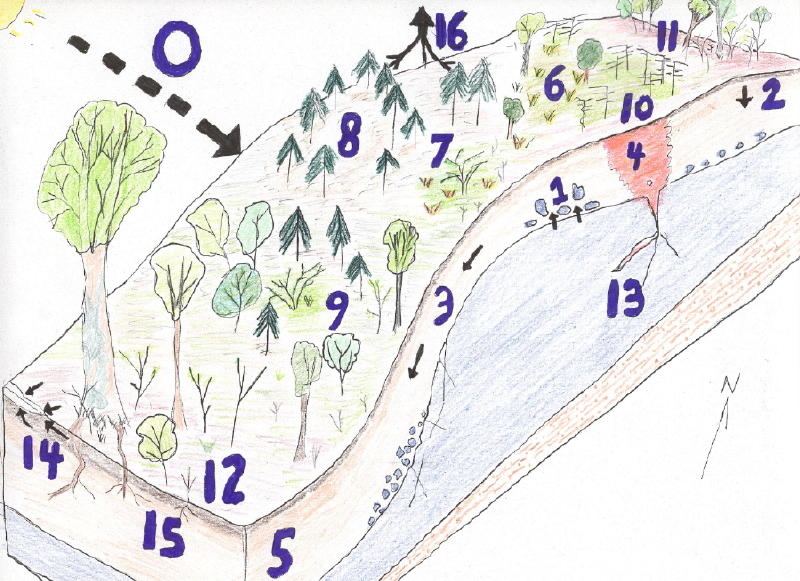
The hypothetical S. IN ecosystem that is the subject of this web site consists of a variety of plant types occurring in different abundances and proportions throughout the areal extent of the old field. Some parts of the the field may be dominated by a pine forest, another a grassy area with a grove of sumac. Another place may have an older yellow poplar or black cherry surrounded by redbud, dogwood, autumn olive thickets or sassafras groves. Yet another, may consist of red cedar, grasses, and prairie wildflowers. In some portions of the field, their may be a Autumn olive tree with 4 meters diameter crown surrounded by grasses. Some areas may have high species richness, while in others it is low.
These vegetation distribution patterns may be caused by a combination of a large number of factors, including:
Many of these factors are interrelated, intimately linked to one another in a complex system.
The diagram below illustrates some of this interrelatedness and ecosystem complexity. The table beneath the figure describes the ecosystem processes that occur at the locations numbered on the figure.

| Map ID | Activity | Related Work | References | ||
| 0 | Energy from the sun - used by plants for photosynthesis, warming and drying the soil, providing the timing for plant life histories | ||||
| 1 | Weathering of Bedrock Contributes ions, soil pH, soil Phosphorus, the soil texture and clay content. Multiple Scales of Soil Heterogeneity | McCormick's Creek State Park Section is example of Limestone weathering;Velbel - Coweeta work, Hobbie - Glacial history effect on pH in tundra, Gabe Fillipini - P in soils, Knops and Tilman - N and C | Hobbie et al., 2002; <br> Knops and Tilman, 2000 | ||
| 2 | water enters and moves down through the soil profile, translocating clays and cations, Litter accumulates and is decomposed and N2 air penetrates soil, then n-fixation or ammonification and nitrification make N available to plants | Watershed analyses of basins involved in research | Eidem et al., 1999; Schlesinger, 1997 | ||
| 3 | Soil is thin on upper and mid slopes (due to erosional dynamics) - groundwater moves downslope eventually to move into a nearby stream | Johnston - Soil + regolith thickness mapping | Taylor and Eggleton, 2001 | ||
| 4 | Oxidized zone in soil above eroded bedrock fracture intersections - groundwater recharge of fractures in bedrock? | hydrologic variability - specifically hydraulic conductivity on large scales (very detailed) | |||
| 5 | Thicker bottomland soil, contains some alluvial sediment. Moisture Contents expected to be higher at this location | Johnston - Soil + regolith thickness mapping | |||
| 6 | Grasses and Red Cedars are some of the dominant vegetation on the higher elevation portions of the field. Succession has occurred much slower in these portions of the field than in others. | Tilman, Gross, other Old - Field Work | |||
| 7 | Invasive shrubs and vines such as Autumn Olive exist throughout pilot study field (Griffy Preserve) | Luke and Keith Clay - Invasives | |||
| 8 | Seed pool and bank are important determinants of which plants will colonize where in a field | ||||
| 9 | lower S facing slope vegetation is likely on thinner soil | ||||
| 10 | Sumac groves dominate some areas | ||||
| 11 | Higher pH if on Limestone, High Biodiversiy | ||||
| 12 | Plant communities in the bottom lands are expected to be more diverse than those of the mid-slopes and hilltops | ||||
| 13 | recharge of fractures in bedrock | ||||
| 14 | Much of the water that moves through this system will find its way into the stream. Plant roots tap into pockets of Nutrient. Multiple Scales of Soil Heterogeneity | Collins and Wein, 1998 | |||
| 15 | AMF mutualistic associations help plants | Jim Bever - AMF | |||
| 16 | Plants give off CO2, they transpire, Soil bacteria transform NO3- to N2 (process called denitrification) | Jean Bahr - denitrification in Riparian wetland | Schlesinger, 1997 | ||
| 17 | History of Land use strongly influences the system | ||||
| 18 | The system teaches us restoration and sustainability | Holl - Coal Mine Reclamation, | Holl, 2002 | ||
References
Collins, B., and Wein, G., 1998, Soil resource heterogeneity effects on early succession. Oikos, 82: 238-245
Eidem et al., 1999, Geology, Groundwater Flow, and Water Quality in the Walnut Creek Watershed. Journal of Environmental Quality, 28: 60-69
Hobbie, S.E., Miley, T.A., and Weiss, M.S., 2002, Carbon and Nitrogen Cycling in Soils from Acidic and Nonacidic Tundra with Different Glacial Histories in Northern Alaska
Holl, K.D, 2002, Long-term vegetation recovery on reclaimed coal surface mines in the eastern USA. Journal of Applied Ecology, 39:960-970
Knops, J.M.H., Tilman, D., 2000, Dynamics of soil nitrogen and carbon accumulation for 61 years after agricultural abandonment. Ecology, 81: 88-98
Schlesinger, W.H., 1997, Biogeochemistry An Analysis of Global Change - Second Edition. Academic Press, San Diego, CA
Taylor, G. and Eggleton, R.A., 2001, Regolith Geology and Geomorphology. John Wiley and Sons, Chichester, England